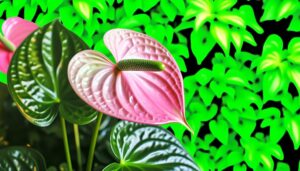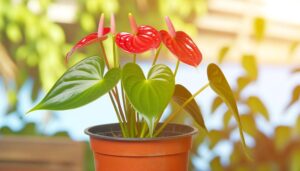Discovering the Origins and Natural Habitat of the Anthurium Flamingo Lily
The Anthurium Flamingo Lily, formally classified within the Araceae family, was initially documented by European botanists in the 19th century. It thrives in the tropical rainforests of Colombia, Ecuador, Panama, and Venezuela, reflecting significant biodiversity.
The plant requires high humidity, well-draining organic-rich soil, and temperatures ranging from 70-85°F (21-29°C). Adapted to indirect light in dense canopy environments, it shows ecological resilience with thick, waxy leaves and aerial roots.
Conservation efforts focus on habitat preservation and sustainable cultivation practices. By understanding more, one can grasp the intricate details of its natural habitat and survival strategies.

Key Takeaways
- The Anthurium flamingo lily is native to Colombia, Ecuador, Panama, and Venezuela.
- It thrives in high humidity environments with well-draining, organic-rich soil and indirect light.
- Ideal growth conditions include temperatures between 70-85°F and humidity levels between 70-80%.
- The plant adapts well to the shaded understories of tropical rainforests with dappled sunlight.
- Conservation efforts focus on habitat preservation, sustainable cultivation, and climate change mitigation.
Historical Background
The historical background of the Anthurium flamingo lily traces its origins to the tropical rainforests of Central and South America, where it was first documented by European botanists in the 19th century. The genus Anthurium, classified under the Araceae family, intrigued early botanists with its unique inflorescence and vibrant spathes.
Detailed botanical records from this era reveal meticulous studies of its morphology and reproductive biology, with particular focus on its spadix and spathe structures. These initial discoveries laid the foundation for subsequent taxonomic classification and horticultural interest.
Moreover, the species' adaptability to various microhabitats within its native range underscored its evolutionary success, sparking extensive scientific inquiry into its ecological and physiological traits.
Geographic Distribution
The Anthurium Flamingo Lily is mainly native to the tropical rainforests of Central and South America. It thrives in regions characterized by high humidity and consistent temperatures. These areas provide the best conditions for its growth, including a nutrient-rich substrate and partial shade.
Understanding these native habitats is important for replicating best growth conditions in cultivation practices worldwide.
Native Regions Explored
Originating primarily from the tropical rainforests of Central and South America, Anthurium Flamingo Lily thrives in regions characterized by high humidity and consistent rainfall. Its geographic distribution spans several countries, each offering unique ecological niches:
- Colombia: Home to diverse cloud forests, Colombia provides the ideal microclimates for Anthurium species, with its lush, moisture-rich environments.
- Ecuador: The Andean slopes and Amazon basin in Ecuador offer varied altitudinal gradients, supporting distinct Anthurium populations.
- Panama: With its extensive rainforests and high precipitation levels, Panama serves as an essential habitat, fostering significant genetic diversity.
These regions collectively contribute to the rich biodiversity seen in Anthurium Flamingo Lily, supporting its survival and evolutionary adaptations.
Ideal Growth Conditions
Perfect growth conditions for Anthurium Flamingo Lily require environments with high humidity, consistent moisture levels, and well-draining soil rich in organic matter. Native to the tropical rainforests of Central and South America, this epiphytic plant thrives under the canopy where indirect light prevails.
Best temperatures range from 70-85°F (21-29°C), with minimal tolerance for temperatures below 60°F (15°C). The geographic distribution mainly includes regions such as Colombia, Ecuador, and Venezuela. These areas provide the natural microclimates essential for the species' growth, characterized by frequent rainfall and stable atmospheric humidity.
The plant's natural habitat mimics greenhouse conditions, necessitating specific care practices to replicate these parameters for successful cultivation outside its native range.
Climate Preferences
Anthurium Flamingo Lily thrives in a climate where temperatures consistently range between 20°C to 30°C, reflecting its tropical origins.
High humidity levels, ideally between 70% and 80%, are essential for best growth and physiological function.
Additionally, the plant requires bright, indirect light to maintain its vibrant foliage and inflorescence, as direct sunlight may cause foliar damage.
Ideal Temperature Range
The Flamingo Lily thrives in temperatures ranging between 65°F and 80°F, reflecting its native tropical environment. This temperature range is pivotal for best growth and flowering. Deviations can lead to stress and potential harm.
Key aspects include:
- Temperature Consistency: Maintaining a stable temperature within this range minimizes physiological stress, promoting strong growth and bloom.
- Nighttime Variations: A slight drop in temperature at night (by 5-10°F) is beneficial, mimicking natural tropical conditions and aiding metabolic processes.
- Protection from Extremes: Temperatures below 60°F or above 85°F can impair cellular functions, leading to wilting, leaf damage, and reduced flowering potential.
Understanding these parameters guarantees the Anthurium Flamingo Lily remains vibrant and healthy in cultivation.
Humidity Requirements
Highlighting its tropical origins, the Flamingo Lily demands high humidity levels, ideally between 70% and 80%, to support peak growth and vibrant blooms.
This perennial plant, indigenous to the rainforests of Central and South America, thrives in environments where atmospheric moisture is plentiful. Inadequate humidity can result in subpar physiological function, appearing as leaf browning and diminished floral longevity.
Sustaining consistent humidity levels can be achieved through humidifiers, misting, or pebble trays. Furthermore, clustering multiple plants can establish a microclimate conducive to higher humidity.
It is essential to monitor ambient moisture levels using a hygrometer to guarantee they remain within the best range, thereby enabling the Flamingo Lily to display its characteristic lush foliage and striking flowers.
Light Exposure Needs
Ideal light exposure for Flamingo Lily involves bright, indirect sunlight to mimic its native rainforest understory conditions, promoting strong growth and abundant blooming. This species thrives under specific light conditions that help maintain its best physiological functions:
- Indirect Light: Direct sunlight can scorch the leaves, causing photodamage. A shaded location with filtered light is ideal.
- Consistency: Maintaining a stable light environment prevents stress-induced foliage discoloration and promotes consistent blooming cycles.
- Artificial Lighting: If natural light is insufficient, fluorescent or LED grow lights can substitute, ensuring the plant receives the necessary light spectrum.
Understanding these light requirements is vital for cultivating Anthurium Flamingo Lily effectively, ensuring it mimics the plant's natural habitat and supports its overall health and flowering potential.
Soil Requirements
Anthurium Flamingo Lily thrives in well-draining, aerated soil mixtures that are rich in organic matter to support best root health and growth. The best soil composition guarantees sufficient moisture retention while avoiding waterlogging, thereby reducing the risk of root rot. Key components of the soil mixture include peat, pine bark, and perlite, each contributing distinct benefits to the plant's development.
| Component | Function |
|---|---|
| Peat | Enhances moisture retention and acidity |
| Pine Bark | Improves aeration and drainage |
| Perlite | Increases drainage and prevents compaction |
| Organic Matter | Provides essential nutrients |
The interplay of these elements creates an ideal environment, mirroring the plant's natural habitat, thus fostering vigorous growth and vibrant foliage. This careful balance is essential for maintaining the plant's vitality and aesthetic appeal.
Native Ecosystems
Understanding the soil requirements of the Anthurium Flamingo Lily is closely tied to its adaptation to native ecosystems, where the plant thrives in the humid, shaded understories of tropical rainforests. These environments provide essential conditions for optimal growth, including:
- Humidity: A consistent high humidity level, often exceeding 70%, which is essential for maintaining cellular turgor pressure and preventing desiccation.
- Shade: Dappled sunlight filtering through the dense canopy, which protects the plant from direct solar radiation that could damage its delicate tissues.
- Rich Organic Matter: Decomposing leaf litter and organic matter on the forest floor, supplying crucial nutrients and fostering a well-drained yet moisture-retentive soil environment.
These factors collectively create a microhabitat that supports the physiological needs of the Anthurium Flamingo Lily.
Adaptation Strategies
To thrive in its native tropical rainforest habitat, the Flamingo Lily has developed several key adaptation strategies that enable it to efficiently utilize available resources and withstand environmental stressors. Its thick, waxy leaves reduce water loss through transpiration, an essential feature for surviving periods of low humidity.
In addition, the plant's aerial roots enhance nutrient and moisture absorption from the humid air and organic matter on tree surfaces. The vivid spathes and spadices are not merely ornamental; they play an essential role in attracting pollinators, ensuring reproductive success.
Moreover, the Flamingo Lily's ability to tolerate low light conditions allows it to flourish under the dense forest canopy, where sunlight is sparse. Collectively, these adaptations epitomize the plant's resilience and ecological versatility.
Conservation Efforts
Conservation efforts for the Flamingo Lily focus on habitat preservation, sustainable cultivation practices, and mitigating the impacts of climate change to guarantee the species' long-term survival.
Key strategies include:
- Habitat Preservation: Protecting natural ecosystems where the Flamingo Lily thrives is essential. This involves establishing protected areas and enforcing regulations to prevent deforestation and habitat degradation.
- Sustainable Cultivation: Promoting cultivation techniques that minimize environmental impact, such as reducing pesticide use and optimizing water consumption, ensures the species can be grown without depleting natural resources.
- Climate Change Mitigation: Implementing measures to combat climate change, such as reducing greenhouse gas emissions and enhancing carbon sequestration, is important. These efforts help stabilize climatic conditions that are crucial for the Flamingo Lily's survival.
These multifaceted approaches are necessary for preserving this unique species.
Conclusion
In summation, the anthurium flamingo lily exemplifies ecological elegance and environmental endurance.
Exhibiting specific soil stipulations and climate conditions, this species thrives within its native ecosystems of tropical terrains.
Adaptation strategies have allowed it to flourish despite fluctuating factors, fortifying its resilience.
Current conservation efforts aim to preserve its pristine habitats and promote sustainable propagation.
The anthurium flamingo lily, through scientific scrutiny, stands as a symbol of botanical beauty and biodiversity balance.






